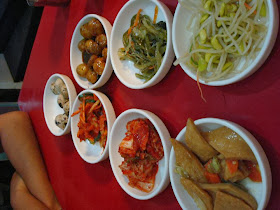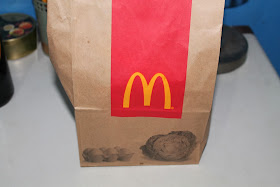Career transition hindered me to
write for awhile, now I’m part of food manufacturing company that is trademark
for French breads. Though, I have been in food business for more than a decade,
bread production is a new genre for me. Baking might mirror a simple process
but understanding technical aspect from raw materials, processes to finished
goods is like Yeast – that causes ferment and agitation to create quality
breads.
Flour is the heart and soul of bread
production – quality flour is every bakers demand! I had the chance to attend a
seminar on Flour Quality Analysis by one of Philippines’ flour milling company.
Attendees are from technical services, quality assurance department, research
and development with aim to understand flour quality parameters, standards and
procedure enabling us to speak in one language in terms of flour technology in
relation to food business.

Background study – Flour Milling
is an art or process of separating endosperm from bran and milling the whole
endosperm into flour. There are three (3) parts to a wheat kernel (sometimes
called a wheat berry): The BRAN is the hard outer covering of the wheat kernel,
high in fiber and nutrients; the GERM is the nutrient-rich embryo that will
sprout and grow into a new wheat plant; and the ENDOSPERM is the biggest part
(80 -83%), the “inside” of the kernel – mostly starch. Take note that white
flour is made from the endosperm only and not whole grain. While, Whole Wheat
Flour is combination of all 3 parts of the whole berry (whole grain).
Four Major Systems of Operation
in Flour Milling Process: First, Breaking system – the function of the first
three breaks is to open up the wheat and break off the bulk endosperm and sizes
it suitably. The last two breaks scrape off the remaining endosperm from bran
as clean as possible. Second, Purification system – is a process concerned with
separating of bran particles from good endosperm stock. Purifiers also grade
endosperm stock into various size particle ranges for efficient reduction or
grinding. Third, Reduction system – is to grind the purified endosperm into
flour of desired fineness and as to uniform granulation as possible without
excessive damage to starch granules or gluten quality. Lastly, the Sifting
system – is classifying or sourcing out of ground stocks mostly coming from
break and reduction systems according to size or granulation.
After yielding Flour as end
product its time to test quality to determine how this flour will perform in bakery
according to customer’s specifications and how consistent flour quality; during
our training limitations we’re set: There are limitations to flour
specifications, flour specifications only give an indication to quality, flour
quality cannot guarantee quality due to variations in shop conditions, and,
there are variations due to weather and human induced conditions. For customers
get what he wants, first, the baker needs to understand his needs. Second, he
needs to understand what tests his flour suppliers do. Third, co-relate his
needs with the flour test done by millers. Lastly, specify the flour he wants.
In general, a bakery or
customer’s flour specification requires physical, analytical, rheological,
microbiological, nutritional and functional. For Physical Specifications, this includes
general description, wheat mix, color, odor and foreign material. Under
physical the most critical parameter is the color since color often affects the
color of the finished product. Generally speaking, bright white color flour is
more desirable for many products. Color testing is subjective through visual
inspection, thus, for a more qualitative and acceptable result – the Minolta
Chroma Meter Test is one reliable method. This method reminds me of
spectrophotometer in terms of technology wherein flour color results are
reported in terms of 3-dimensional color values. Sample of flour is placed on
granular materials attachment and compacted. The Minolta Chroma Meter is
inserted into the granular materials attachment, then, flour color is
determined by measuring the L value or whiteness. In Europe, bakers prefers
darker to yellowish color of flour as they believe the more whiter the more
additives was involved altering quality.
Analytical Specifications is more
technical, most food industry has no resources to determine actual value of
moisture content, ash, protein, enzymatic activity and oxidation treatment.
Thus, most of us relay on submitted Certificate of Analysis. Protein content is
the most important measurable flour characteristic; it is responsible for the
formation of the framework of the baked product since it is related to many
processing properties, such as water absorption and gluten strength. Protein
content can also related to finished product attributes, such as texture and
appearance. Protein content is determined through Kejldahl process or high
temperature combustion in a protein analyzer. Since protein is the major wheat
compound that contains Nitrogen, the protein content can be determined by
measuring the amount of Nitrogen released during burning.



Gluten is responsible for the
elasticity and extensibility characteristics of flour dough, the very reason
wet gluten is common flour specification required by end users in the food
industry. When I was in Universal Robina Corporation, I conduct daily wet
gluten analysis for flour to be used in manufacturing crackers to provide
information on the quantity and estimate the quality of gluten in flour sample.
The manual method requires approximately 2 hours completing the test and your
hands literally on labor. Thank heaven for technology with the invention of
Glutomatic/Machine-washed that within 20 minutes accurate gluten percentage is
provided. The procedure is to wash the flour sample with salt solution to remove
the starch and other soluble; the residue remaining after washing is the wet
gluten. During centrifugation, the gluten is forced through a sieve. The
percentage of gluten remaining on the sieve is defined as the gluten index,
which is an indication of gluten strength. A high gluten index indicates strong
gluten.



Ash is the mineral residue
remaining after incinerating a small amount of flour; ash provides an estimate
of the degree of separation of bran and germ from the endosperm. Since ash is
primarily concentrated in the bran, ash content in flour is an indication of
the yield that can be expected during milling. For Ash Test Method, a sample of
flour or ground wheat (approximately 5 grams) is weighed and placed in ash cup.
The sample is heated at 585oC – 600oC n ash furnace until
its weight is stable (usually overnight). Then, the residue is cooled to room
temperature and then weighed.



Determining moisture content is
an essential first step in analyzing wheat or flour quality since this data is
used for other tests. Flour millers adjust the moisture content in wheat to
standard level milling as indicator of grain storability and profitability.
Moisture Test Method – a small sample of flour (2 grams) is weighed and placed
in a moisture dish; the sample is heated at 135oC in an air oven for
2 hours and then sample is cooled to room temperature and residue is weighed.
There is more convenient and faster way to determine moisture content through
Infrared Moisture analyzers that guarantee result in less than 10 minutes.


The falling number instrument
analyzes viscosity by measuring the resistance of a flour and water paste to a
falling stirrer. Since starch provides the supporting structure of bread, too
much activity results in sticky dough during processing and poor texture in the
finished product. A high falling number (for example, above 300 seconds)
indicates minimal enzymes activity and sound quality flour, while, a low
falling number (for example below 250 seconds) indicates substantial enzymes
activity and sprout-damaged flour.
Rheological means mix-study of
flour sample with water for Farinograph, Extensigraph, Alveograph and
Amylograph tests. Farinograph determines dough and gluten properties of flour
by measuring the resistance of the dough against the mixing action of the
paddles. Results include absorption, arrival time (indicates the rate of flour
hydration), stability time (indicates the time dough maintains maximum
consistency), peak time (indicates dough development time, beginning the moment
water is added until dough reaches maximum consistency), departure time and
mixing tolerance index. The method requires a 50 or 300 grams flour sample on a
14% moisture basis and placed into the corresponding farinograph mixing bowl;
water from a burette is added to the flour and mixed to form dough; as the
dough is mixed, the farinigraph records a curve on a graph paper.

Weak Gluten Flour has a lower
water absorption, shorter peak or development time, shorter stability time,
shorter time to breakdown, and greater MTI or degree of softening during mixing
that strong gluten flour. The Farinograph Test is one of the most commonly used
flour quality tests in the world. The results are used as parameters in
formulation: to estimate the amount of water required to make dough, to
evaluate the effects of ingredients on mixing properties, to evaluate flour
blending requirements, and to check flour uniformity.
Extensigraph determines the
resistance and extensibility of dough by measuring the force required to stretch
the dough with a hook until it breaks. Extensigraph results includes resistance
to extension, extensibility, and area under the curve used as parameters in
formulation: to evaluate the dough behavior due to fermentation, to evaluate
the effects of additives on dough behavior, to evaluate flour blending
requirements, and to check flour uniformity.



The Amylograph Test measures four
starch properties and enzyme activity which results from sprout damage (alpha
amylase enzyme activity); sprouting in wheat, as indicated by high enzyme
activity, produces sticky dough that can cause problems during processing and
results in products with poor color and texture. For Asian noodle products,
flour of medium to high peak viscosity is preferred because it gives noodles
better texture characteristics. The method requires 65g flour sample combined
with 450ml distilled water and mixed to make a slurry; the slurry is stirred
while being heated in the amylogrpah, beginning at 300oC and
increasing at a constant rate of 1.5oC per minute until the slurry
reaches 95oC. The amylograph records the resistance to stirring as a
viscosity curve on graph paper.
Its time now to review our test
method procedures and update methodology for flour analysis.
































































